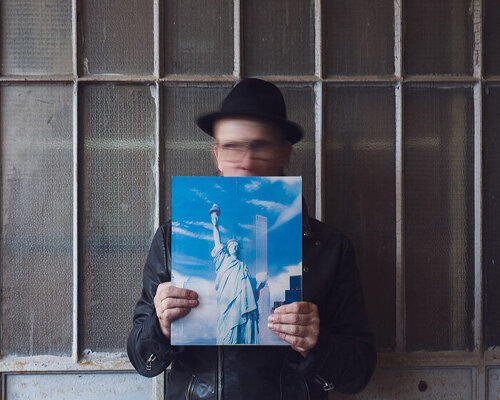MANFREDI LUCIBELLO REVISITS CONTEMPORARY ART’S GREATEST HOAX
In his latest documentary, The Tirana Conspiracy (Il complotto di Tirana), director Manfredi Lucibello dissects one of the most outrageous and revealing hoaxes in the history of contemporary art, the real-life episode that exposed the art world’s blind faith in provocation and its vulnerability to manipulation. Produced by Small Boss with the support of Regione Emilia-Romagna, the 71-minute film brings together photographer Oliviero Toscani, artist Marco Lavagetto, and a cast of art-world insiders to revisit the events that shook the first Tirana Biennial 25 years ago, in December 2000.
The film unpacks how, in an age before social media but already steeped in digital illusion, a young artist managed to deceive one of Europe’s most powerful critics and an entire institutional ecosystem. In 1999, Flash Art magazine published a ranking of Italy’s top fifty artists. Toscani, famed for his boundary-pushing Benetton campaigns, appeared second to last, just above Marco Lavagetto, dubbed ‘the poor man’s Cattelan.’ A year later, Lavagetto struck back with what he would later describe as ‘one of the biggest media hoaxes of contemporary art.’ Pretending to be Toscani, he began an email exchange with Flash Art’s editor Giancarlo Politi, who soon invited the supposed photographer to curate a section of the inaugural Tirana Biennial.
images courtesy of Clara Vannucci
THE TIRANA CONSPIRACY: four fake artists and one real scandal
For the exhibition, the ‘fake Toscani’ proposed four equally fake artists, designed to stretch the moral and conceptual limits of the art world: Dimitri Bioy, a self-declared pedophile; Bola Ecua, a Nigerian activist allegedly pursued by her government; Carmelo Gavotta, a pornographer (and an anagram of Lavagetto’s own name); and Hamid Picardo, Bin Laden’s ‘official photographer.’ These characters formed a grotesque mirror of contemporary art’s appetite for scandal and shock value.
The deception that director Manfredi Lucibello’s documentary unravels extended beyond the artwork, as Lavagetto also offered to design the Biennial’s poster free of charge, producing an image of the Albanian flag modified into that of the Kosovo Liberation Army, a deeply provocative gesture at a moment when the region was still torn by post-war tension. When Politi printed the official catalogue and sent it to the real Toscani, the photographer finally discovered that his name had been hijacked.
Manfredi Lucibello dissects one of the most outrageous hoaxes in the history of contemporary art
questioning what’s real in art and in film
Even after Lavagetto’s confession, many continued to believe the four artists actually existed. The real Toscani filed a complaint for identity theft, and Italian police eventually traced the emails back to Lavagetto’s computer. The trial ended with Lavagetto’s acquittal on criminal charges but a civil conviction. He was ordered to pay €30,000 in damages, the same amount Toscani had already received from Flash Art. The verdict, Lucibello notes, symbolically shared the guilt between those who created the deception and those who ‘took the bait.’
Through interviews, archival material, and reenactments, The Tirana Conspiracy reconstructs how this elaborate hoax not only humiliated key figures but also revealed the art system’s fragile underpinnings, its market-driven narratives, dependence on reputation, and willingness to sanctify controversy as depth. As Lucibello frames it, the operation became a mirror for an industry that had ‘plunged the knife into its own weak points.’ Yet, 25 years later, the director observes, little seems to have changed. ‘The Tirana Conspiracy,’ he notes, ‘had the merit of exposing the sickness of the system but the shortcoming of failing to cure it.’
Lucibello uses the story not only to probe the nature of art but also to question his own medium. Citing the Treccani definition of documentary, a film based on an ontological relationship with reality, the director wonders what happens when reality itself is a fabrication. ‘My camera will be at the service of reality,’ he concludes. ‘But what if there is no reality? I will have no choice but to represent it for what it is: a lie.’ The Tirana Conspiracy becomes a meta-documentary, a film about deception that doubts the truthfulness of its own form. Lucibello turns the hoax into an ethical question for both artists and viewers. What if the greatest artwork is the lie we choose to believe?
the 71-minute film brings together Oliviero Toscani, Marco Lavagetto, and a cast of art-world insiders
revisiting the events that shook the first Tirana Biennial 25 years ago
the film unpacks how a young artist managed to deceive one of europe’s most powerful critics
project info:
name: The Tirana Conspiracy
director: Manfredi Lucibello | @manfredilucibello
producer: Matteo Pecorara
cinematography: Matteo Ferrarini
editing: Diego Berrè
color grading: Emilio-Maria Costa
sound design: Francesco Rabaglia
prosthetic make-up: Valentina Visintin
visual effects: Ignacio Herr
artwork: Mattia Donati
production: Small Boss | @smallbossproduction, with the support of Regione Emilia-Romagna
country: Italy
year: 2024
length: 71 minutes
language: Italian
subtitles: English
format: DCP (16:9, Dolby 5:1)
The post the art hoax that fooled everyone: manfredi lucibello unravels the tirana biennial’s deception appeared first on designboom | architecture & design magazine.

